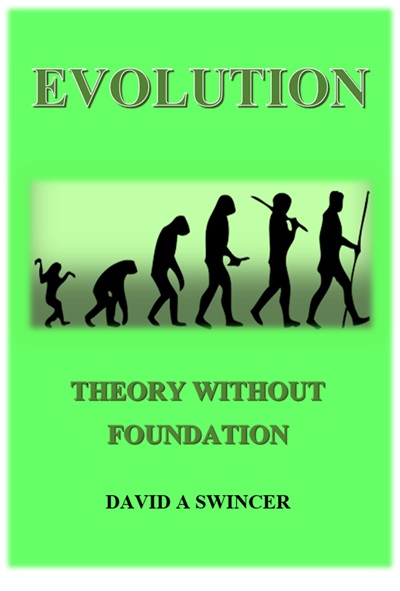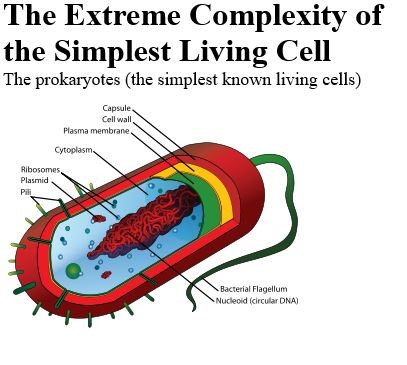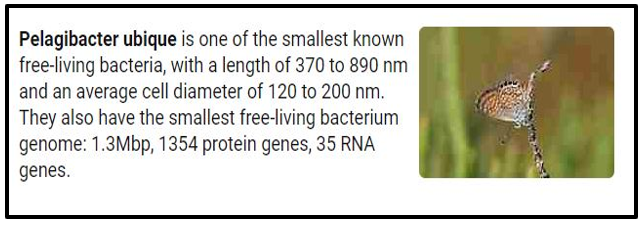
EVOLUTION: THEORY WITHOUT FOUNDATION
EXTENDED INFORMATION
There have been SEVEN previous IMPOSSIBILITIES for the unfounded theory of evolution. Now we address the Daddy of them all:
SIMPLEST LIVING CELL (ABIOGENESIS)
Assuming the impossible—that we can somehow obtain a small pond to be the environment for the first and most basic form of life—a single cell—how do we transition from nothing—except the pond of water—to the first single cell?
This is a quantum leap of impossible proportions. The further we go, the more impossible the evolutionary solution becomes.
Look carefully at the diagram of the simple cell (below). From absolutely nothing, there is supposedly the sudden appearance of this cell. Imagine the chemicals that randomly and spontaneously combine to form the various parts—capsule, cell wall, plasma membrane, ribosomes, cytoplasm, etc., and especially the nucleoid. It would need a carefully regulated chemical laboratory to produce the parts, with very exact composition.

**NOTE: SERIOUS PROBLEM:
IRREDUCIBLE COMPLEXITY!
A system performing a given basic function is irreducibly complex if it includes a set of well-matched, mutually interacting, nonarbitrarily individuated parts such that each part in the set is indispensable to maintaining the system's basic, and therefore original, function. The set of these indispensable parts is known as the irreducible core of the system.
Irreducible Complexity.
This means that the simplest living cell cannot be reduced beyond the minimal parameters as shown in the diagram, and still be a living cell. A membrane, or the cytoplasm, or any other part is not able to exist independently—let alone to “form” spontaneously over millions of years. There is just no “in-between” stage from the pond of water to the first completed simplest living cell. Irreducible complexity renders this step impossible—unless there is a God.
There has to be the inexplicable materialisation of a multiplicity of atoms into a complex of molecules of a very large variety of chemicals in exact proportion and structure to form all the parts so that they are in perfect harmony and function—and simultaneously! Any attempt at something simpler, and it will all shrivel up. To be a living cell it has to be perfectly balanced.
**NOTE: THE SIZE OF THIS CELL
To get an idea of the size, compare the size of one of the smallest known bacteria in the following.

NB: nm = nanometre. Nano-, is a prefix that indicates one thousand millionth.
So, take 1 metre, and divide it into 1,000,000,000 parts. Then take 200 of these infinitesimally small particles, and that is the approximate size of the smallest living cell!!
This is microsurgery in the extreme—and all supposedly by chance. And all the complexity of this one single cell.
**NOTE: THE PRESENCE OF DNA in the nucleoid of the simplest cell, exacerbates the problem astronomically.
DNA was unheard of when Darwin conceived his impossible theory. He would have been embarrassed to find how seriously it impacted on his unsubstantiated presuppositions.
Note the DNA in the simplest cells, shown in this example from Amoeba dubia.

From this information, we can deduce that the Amoeba dubia has a genome 230 times larger than the human genome. (The human genome has over 3,000,000,000 base pairs). But according to evolution, the start is supposed to be simple (simple single living cell), moving to the complex (human being). The scientific evidence says the opposite concerning DNA.
What mechanism can explain the sudden arrival of such a hugely complex genome? All 670 billion intricate and specifically designated parts! AND all the other complex molecules of the same one “simple” cell! And all at once out of nothing! Creation ex nihilo!!?
______________________________________________________________________________________
CONTENTS PAGE:
DOUBLE LEFT CLICK:
EVOLUTION - CONTENTS - PDF.pdf